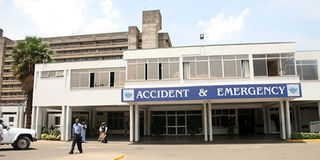The road to devolution lacks clear role division

Kenyatta National Hospital. PHOTO | FILE
What you need to know:
- There is great discrepancy between facilities in rural and urban areas, a situation that is sure to be magnified by devolution
- Uncertainty about who is responsible for what in the health sector could potentially result in drug stock-outs
According to the Musyimi Task force report of July 2013, Kenya’s population stands at 44,037,656, with a total of 9,124 hospital beds spread out over 47 counties in public health facilities (district hospitals, health centres and dispensaries).
The report also indicates that 27.4 per cent of the population had suffered from some kind of illness during the four weeks prior to the survey.
The prevalence of illnesses was relatively higher for females (30.1 per cent) than for males (24.7 per cent).
According to the report, the bed capacity in Kisumu and Kisii counties was 200 and 150 respectively, with Isiolo and Lamu counties having the lowest bed capacity of fewer than 100 beds each.
It is notable that there is great discrepancy between facilities in rural and urban areas, a situation that is sure to be magnified by devolution.
The Health Ministry held a consultative meeting to discuss the devolution of health care in the country. Among the things discussed were devolution and health, devolution and human resource allocation, and health but some of the action points agreed on are yet to be implemented.
“The data on bed capacity signify that Kenya, indeed, has a problem delivering quality accessible healthcare to its people,” the report noted.
In December 2011, the Kenya Medical Practitioners, Pharmacists and Dentists’ Union (KMPDU) held a meeting with the government to work out ways of strengthening the health sector, with specific reference to infrastructure and staffing.
The discussion was based on how to increase funding for health, the formation of a health services commission, improvements in infrastructure and supplies, compensation for doctors undergoing specialised training (registrars) and a strategy for human resource development, recruitment and retention.
LACK OF CLARITY
The devolution of health services has proved challenging in other countries, especially where there is lack of clarity as to which level of government is responsible for which services. This is often linked to inadequate funds at the different levels of government.
According to the Musyimi report, the task force focused on the health sector because it is the most important and expensive social sector, and is one where the consequences of failure in service delivery can have a major impact on people’s lives.
Uncertainty about who is responsible for what in the health sector could potentially result in drug stock-outs, breakdown of morgues and cemeteries, and rubbish accumulating in public spaces, spreading disease.
The report revealed that there was lack of clarity both about the functions that will be carried out by each level of government, and about the process for determining these. There was also insufficient information about the costs of delivering key services and how funds would be shared between the different levels of government.
“It is not clear who is going to run provincial hospitals. Responsibility for recurrent and development expenditure for the same activities is divided between the national and county governments, which is inconsistent with the recommendations of the Taskforce on Devolved Government and might lead to serious coordination problems,” noted the report.
Some services that clearly require national government to play a role, such as management of the health information system, appear to have been fully devolved in terms of financing in ways that threaten their sustainability, lack adequate explanation and might undermine accountability.




